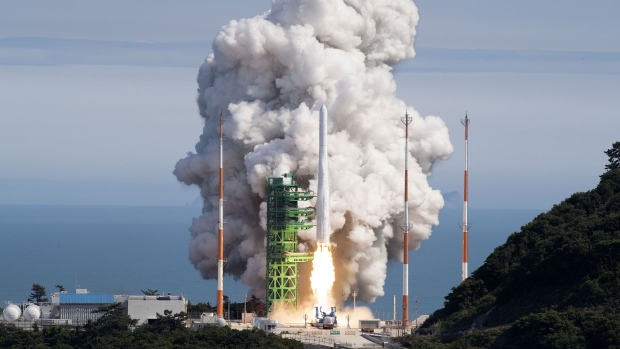May 27, 2024
South Korea Is Gearing Up to Become Space Powerhouse
, Bloomberg News

(Bloomberg) -- From Samsung’s smartphones to SK Hynix’s semiconductors, South Korean companies have spent decades catching up to – and in many cases then overtaking – powerful rivals from the US, Japan and other countries.
So far, the country has been an also-ran in the space industry, with weak funding and a few technology flops. But a new wave of government officials like Lee Jong Ho is betting that history could repeat itself.
The country’s minister of science and technologies, Lee oversees a new space agency that was launched Monday with a mission to propel South Korea into the ranks of major space nations. The government is planning to double the current annual space budget by 2027 to 1.5 trillion won ($1.1 billion).
While South Korea got off to a late start in space, the country has proven it can leapfrog nations, according to Lee.
“When I was young, people used to say that hoping Korea would become a semiconductor powerhouse was like hoping for a rose to bloom in a garbage can,” Lee said in an interview this month. “However, we managed to do it.”
President Yoon Suk Yeol’s administration is spending 2 trillion won on a new rocket program and another 3.7 trillion won for navigation satellites.
The country launched the Nuri, its first locally developed rocket, in 2021 and a year later it deployed its first satellite. Last month, a SpaceX rocket put in orbit a military surveillance satellite for Seoul. This was the second in a series of launches using home-grown probes aimed at putting five South Korean-made spy satellites into orbit by 2025.
Read more: South Korea Deploys Second Homegrown Spy Satellite From US
Despite these achievements, South Korea’s space program lags that of neighbors Japan and China. North Korea has also made inroads by using its ballistic missile program as a springboard to develop rocket engines and technology.
As part of its plans to fast-track development, the South Korean government is looking to set up a launching facility in the southern coastal Goheung area for private companies as well as a space-related fund with more than 100 billion won to support private-sector space companies.
The next step came with the official opening of a new space agency, modeled on NASA, and named the Korea AeroSpace Administration, or KASA.
“We need to learn from nations that have plenty of experience in the field of space,” said Lee. “KASA is benchmarked to NASA’s model in many ways.”
That’s one reason the new head of the agency’s R&D program is John Lee, a 30-year NASA veteran who most recently served as a senior adviser at the Goddard Space Flight Center in Maryland.
KASA will also work on ambitious projects such as an uncrewed moon landing by 2032, with a Mars mission proposed by the middle of the following decade.
With the new space agency, the government is looking to build on its industrial policies over the past half century, when state support provided the lift that upstarts like Samsung Electronics Co. Ltd. and LG Electronics Inc. needed to gain access to technology and become globally competitive.
Optimists look to Korea’s shipbuilding industry as an indicator of what could happen in the space sector, said Byunghwan Son, associate professor in the Global Affairs Program at George Mason University.
“In the 1980s the government identified [shipbuilding] as a thing we have to do and said let’s concentrate all the resources onto it,” he said. “All the money went there and they took over global leadership.”
Korean business leaders hope “this is the next shipbuilding,” Son said.
Korea Aerospace Industries Ltd. plans on using SpaceX to launch two satellites next year. This is part of a government’s road map that aims to transfer state-owned space technology to the private sector.
South Korea’s leading private aerospace company Hanwha Aerospace Co., which is participating into Nuri rocket project with a state-run agency, will also develop the country’s new space rocket capable of sending a lunar lander to the moon.
LIG Nex1 Co., a major supplier of defense weapons systems, is one of the government’s partners in the development of the new GPS-like satellite network, the Korean Positioning System.
In March, LIG Nex1 took part in an 8 billion won investment in Dabeeo Inc., a Seoul-based startup specializing in AI technology for satellite imagery.
The creation of KASA is important in part because of the role that industrial policy has played in the country’s development, said Munseob Lee, assistant professor in the University of California San Diego’s School of Global Policy and Strategy.
“Korean companies have to learn from the US” and other leading nations, he said. To facilitate long-term relationships “It’s better to have a centralized, more powerful and more credible agency.”
The government-guided industry strategy might be more difficult to pull off this time, though, in part because of the major successes that Koreans have already enjoyed in other industries, said UCSD professor Lee.
“Korea was able to catch up quickly because Japan and the US were quite willing to sell their technology,” he said. “In the long run, it’s risky because it’s possible that Korean firms can catch up and become the number one producer.”
©2024 Bloomberg L.P.





